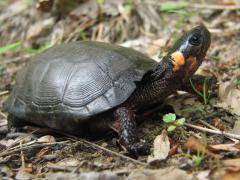Bog Turtle
Over the past 20 years, the bog turtle population has declined by at least 50% across the United States.
 Bog turtles inhabit open, unpolluted wetlands, including spring-fed fens, sphagnum bogs, and wet pastures. (c) Brian Zarate
Bog turtles inhabit open, unpolluted wetlands, including spring-fed fens, sphagnum bogs, and wet pastures. (c) Brian Zarate
Over the past 20 years, the bog turtle population has declined by at least 50 percent, prompting the U.S. Fish and Wildlife Service (USFWS) to list it as federally threatened in 1997. Historically, the bog turtle ranged from upstate New York through Georgia and as far west as Tennessee. The northern range of the bog turtle consists of small, disjunct populations in Connecticut, Delaware, Maryland, New York, and Pennsylvania with more than half of the northern population in New Jersey. Even in New Jersey, a range-wide stronghold for the species, bog turtles have disappeared from more than 50% of their historically occupied sites and have been state-listed as endangered since 1973.
 Zoom+ The bog turtle is the smallest turtle in North America, reaching only 4 inches at maturity. (c) Brian Zarate
Zoom+ The bog turtle is the smallest turtle in North America, reaching only 4 inches at maturity. (c) Brian Zarate
Reaching only 4 inches at maturity, the bog turtle, Glyptemys muhlenbergii, is the smallest turtle in North America. These turtles have a moderately domed dark brown shell and dark brown legs with red or yellow markings, and a distinctive orange patch at the rear of the head. The carapace (top shell) may have a yellowish hue and is weakly keeled along the midpoint. The plastron (bottom shell) is hingeless with yellow markings in the middle. Each scute (or scale) on the shell displays a pattern of concentric circles, or annuli; these ridges can be used to age a turtle, although they are less defined in older adults. Males are distinguished from females by a concave plastron, longer foreclaws, and a thicker, longer tail.
These small, secretive turtles are habitat specialists, inhabiting open, unpolluted wetlands, including spring-fed fens, sphagnum bogs, and wet pastures. Frequently these habitats are linked along streams which create important movement corridors between populations. Bog turtles require both mucky soils with small pools of groundwater and drier upland areas with low vegetation and sparse tree cover. This habitat allows turtles to thermoregulate by burrowing into the mud or basking on emergent vegetation.
These small, secretive turtles are habitat specialists, inhabiting open, unpolluted wetlands, including spring-fed fens, sphagnum bogs, and wet pastures.
After emerging from hibernation in April, bog turtles spend the majority of the time basking and feeding on seeds, slugs, snails, and other invertebrates. Turtles then mate and females lay 1 to 6 eggs on elevated grassy tussocks in early summer. The eggs are left to incubate in the sun for 6 to 8 weeks and hatchlings emerge in late August. Eggs and juvenile bog turtles are highly susceptible to predation by birds, raccoons, and small mammals, but those that do survive may live over 50 years. As temperatures cool in October, bog turtles will retreat to forested wetland habitats where they hibernate in mucky soils around root systems of trees and abandoned small mammal burrows.
 Zoom+ Juvenile bog turtles are highly susceptible to predation by birds, raccoons, and other small mammals. Those that do survive may live over 50 years. (c) Brian Zarate
Zoom+ Juvenile bog turtles are highly susceptible to predation by birds, raccoons, and other small mammals. Those that do survive may live over 50 years. (c) Brian Zarate
As with most species in New Jersey, habitat loss is the driving force in the bog turtle’s decline. The early successional communities where bog turtles reside are especially vulnerable. As development increases, we lose natural disturbances like fire and beavers that maintain and create early successional habitat. Without these influences, woody vegetation matures, changing hydrology and solar exposure. Ditching and draining of these wetlands to create farmland and development not only directly destroys habitat but degrades surrounding wetlands as increased runoff and sedimentation creates ideal conditions for phragmites, reed canary grass, and purple loosestrife. These non-native plants form monocultures, out-competing the native plant communities that bog turtles depend upon. Fragmentation of habitat and stream corridors may isolate populations, eliminating gene flow, lowering genetic diversity, and increasing vulnerability to extirpation. Loss of these communities also has broader implications, as rare plants like spreading globe flower and showy lady slipper, native pollinators, scrub-shrub/grassland birds, and a suite of reptiles and amphibians all depend upon this early successional habitat.
Fortunately, many simple management tools can maintain and restore these critical habitats. Mechanical removal, wetland approved herbicides, and biological tools, like beetles, can remove woody vegetation and control invasive species. Grazing of cattle, goats, and other livestock can replicate the effects of historic natural disturbances like fire, beavers, and bison that have been suppressed or eliminated with development. By restoring these wetland communities, we also improve water quality, reduce runoff, stabilize buffer areas with native perennials, and reduce invasive plant cover.
Over 70% of the remaining bog turtle sites in New Jersey are on private land. Engaging private landowners in conservation and incentive programs to protect habitat is the best chance these turtles have. Together with USFWS and NJ’s Endangered and Nongame Species Program (ENSP), CWF is working to restore and enhance bog turtle habitat in New Jersey by reaching out to landowners with bog turtle sites. CWF biologists visit these high priority bog turtle sites, evaluate the status of the habitat, and perform habitat restoration to benefit the bog turtle. By discussing the importance of bog turtle habitat and incentive programs to protect and restore these habitats, CWF hopes to increase awareness and appreciation of bog turtles while protecting and restoring these rare communities.
Find Related Info: Reptiles, Habitat Restoration





